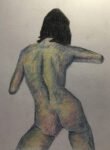After yesterday’s late night fun, I kicked off today with three more experiments with coloured pencil solvents.
First, I had an overnight thought about the way Neil McCarthy came out quite granulated after being blended. Could this have been because I was using cold pressed watercolour paper, which is a bit grainy? Would the solvents work better on something smoother like hot pressed watercolour paper or cartridge paper? When I first started with the coloured pencils, I was using cartridge paper but found it a bit too thin for my liking so moved on to the Seawhite Of Brighton watercolour paper. So I looked through my supplies and found some old swatches on cartridge paper. These are from when I first started out with 36 colours. I have 60 colours now, so no longer use these swatches. Take a look at this:

I don’t have a photo of the original swatches so this will have to do. The top row was blended using a blender pen and the second row using the blending medium. The bottom two rows have been left untouched so you can see the difference. The blending pen has worked brilliantly, making the pencils look very much look like paint. The blending medium has less of an effect, leading to something that’s somewhere between pencils and granulating watercolour. It may even grey the colours slightly, although they’re starting to look. Better as they dry. Not displeasing.
The before painting is on the left, after on the right. I used the blender pen in Jen’s lower right arm and the blender medium everywhere else. The pen again looks slightly more effective than the medium, at least on this watercolour paper. But both solvents definitely work better on a smooth painting than on a scratchy one. That’s the big conclusion.
Which all begs the question, how would the solvents work on a smooth painting on smooth paper. Sell, I did three coloured pencil paintings on cartridge paper before moving on to watercolour paper. And I decided that
the Sam Allardyce portrait was the one that had the most potential to benefit from blending. So I went for it:

I used the blender pen on Sam’s eyes, ear, nostrils and mouth and the blending medium everywhere else. Except on his shirt and tie, which I forgot about. Let’s talk about the blender pens first. They worked brilliantly again. Whether I’ll ever use them for a whole painting, I don’t know. I don’t know whether the lens themselves have enough capacity, let alone whether I have the patience to use them over large areas. The medium also does something again. It works better over the smoothest areas and those with more colour on the paper: the bright bit in Sam’s forehead is the highlight in more ways than one. I also like what it’s done to Sam’s jacket, though, making the colour more intense while still looking like coloured pencil.
So here are my thoughts:
– blending works better on cartridge paper
– blending works better when there’s more colour in the paper
– blending works better on less scratchy paintings
– I’m not going to apply blender to any of my coloured pencil paintings that are in watercolour paper
– I’m not so thrilled with the results that I’m going to invest in some thick cartridge paper for my coloured pencils
– I will, though, do a couple of coloured paintings on the thinner cartridge paper that I already have and blend them and one of these will probably only use the blender pens
– I’ll also experiment on hot pressed watercolour paper (that’s the smoothest there is)
– if these experiments on smoother paper work, then I’ll invest in more medium and/or blender pens, otherwise I’ll stick to using coloured pencils for grainy looking paintings on cold pressed watercolour paper.
And one more thought. I’m having to keep a window open while this solvent dries. If blended coloured pencil paintings become a thing, they (like charcoal paintings) will become a summer job.
And with that, I’m hanging up my lab coat and planning the next watercolour painting











Leave a Reply